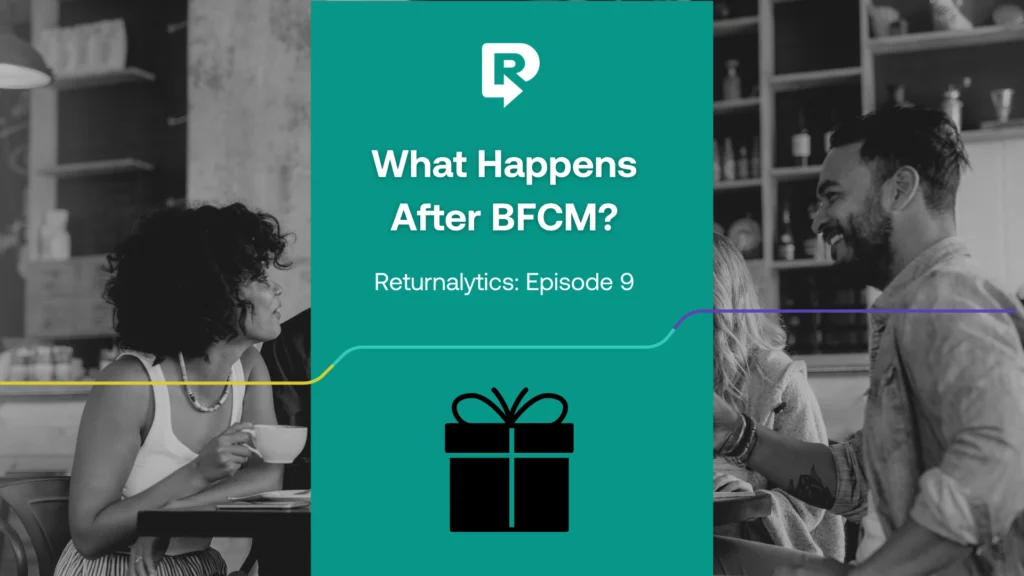Returnalytics: How to manage holiday returns after Black Friday and Cyber Monday

About the Episode
The Returnalytics podcast discusses the latest retail trends, technology, and best practices for managing an ecommerce business and retail returns.
In this episode, we’re discussing what happens with holiday returns after Black Friday and Cyber Monday:
Managing Holiday Returns
Sales aren’t the only thing retailers need to be worried about this holiday season. Shoppers are projected to return $900 billion worth of goods by the end of 2022 with online shoppers making up $280 billion of that – about a 9% uptick from last year.
On average, retailers get 4x as many orders from November 25th to December 25th and about 80% of their returns happen right after that time period as well. Due to inflation, a higher cost of living, higher return shipping costs, and a lot of heavy discounting to move inventory, etc, 2023 will be a record-setting year for returns.
There’s not much time left to prepare for the post-Black Friday / Cyber Monday returns but don’t worry, there’s still hope!
Listen in to learn how you can prepare for the rush of holiday returns on today’s episode. Enjoy!
About the Speakers
Travis Farey
Travis is a Product Marketing Specialist at ReturnLogic. Travis graduated from Shippensburg University with a Bachelor of Science in Supply Chain Management & Marketing. Travis has been working for ReturnLogic for over 2 years and started out as a Customer Support Specialist before working his way into Product Marketing.
David Gonzalez
David is a Senior Growth Manager at ReturnLogic, previously working as a Product Marketing Manager. David has prior startup experience formerly working at Drip and WhenIWork. He works closely with the Product, Sales, and Marketing teams at ReturnLogic to act as the voice of the customer and how to understand the ecommerce market.
Episode Transcription
Travis Farey – 0:00
Hi, I’m Travis Farey and this is the returns management podcast by ReturnLogic; a show where we connect ecommerce store owners together through casual discussion and examine current myths and trends to keep you up to date on everything happening in the ecommerce world.
My name is Travis Farey and I am a Product Marketing Specialist here at ReturnLogic
And today I am joined by David Gonzalez Senior Growth Marketer here at ReturnLogic
So, let’s get this show rolling.
David Gonzalez – 0:00
Ahh… gotta love the holiday season. Get to eat until you hate yourself, argue with relatives, and watch football. The American Dream. However, for our retailers listening, I’m guessing their sentiment might be a little bit different.
Travis Farey – 0:22
Ya David, retailers don’t get the luxury of being lazy like you or I during the Holidays, they’re dealing with their wildest time of year. For perspective, $9.1 Billion dollars got spent online on Black Friday and return rates jumped up to about 26%
David Gonzalez – 0:42
Sheesh. Wanna hear something even crazier?
Travis Farey – 0:44
Yes.
David Gonzalez – 0:49
Shoppers are projected to return $900 Billion by the end of 2022 with online shoppers making up $280 billion of that – about a 9% uptick from last year.
Travis Farey – 1:05
Yikes
David Gonzalez – 1:09
I think one of our retailers mentioned they get 4x as many orders from November 25th to December 25th and about 80% of their returns happen right after that time period as well.
Travis Farey – 1:21
Yup, so they’re not just busy with sales and fulfillment, they’re also busy gearing up with all of those returns about to happen.
David Gonzalez – 1:30
We sound pretty ominous there…
Travis Farey – 1:37
Just trying to prepare our listeners for what will probably be a record-setting year for returns.
David Gonzalez – 1:44
Record-setting? What makes you think that?
Travis Farey – 1:48
Inflation, higher cost of living, highest ever cost of shipping, a lot of heavy discounting to move inventory, etc. I think even just the day after Black Friday there was a 26% uptick in returns compared to last year.
David Gonzalez – 2:05
Sheesh, ya that makes sense. So what can retailers do to make holiday returns go a little smoother? I know we talked about some tips and tricks on an earlier episode but why have holiday returns been so challenging historically?
Travis Farey – 2:24
Great question, let’s dive in.
David Gonzalez – 2:27
Lets do it
Travis Farey – 2:29
Alright so the reasons holiday returns specifically have been difficult to manage boils down to a few things. First, retailers have had to manually go in and tag every item they wanted included in their holiday return policy.
David Gonzalez – 2:45
Oof, that could takes hours if not days for some people

Travis Farey – 2:49
Yup, and after all of that, retailers then had to check every single return against the order date and against their holiday policy.
David Gonzalez – 3:00
Oh man, having to do all of that while juggling fulfillment, sales, emails from shoppers, that’s gotta add up quick.
Travis Farey – 3:09
Exactly, its just really inefficient and ultimately eats into a retailers profitability.
David Gonzalez – 3:15
Makes sense, with all the time and labor manually processing returns during the holidays, there’s probably going to be operational challenges, shipping delays, bottlenecks for CSRs and some chaos in the warehouse.
Travis Farey – 3:29
Absolutely, not to mention burn out is real during the holidays.
David Gonzalez – 3:36
I hear everything you’re saying and agree, but maybe we should walk through an example for our listeners here.
Travis Farey – 3:44
For sure, so let’s say a retailer normally has a 30-day exchange, store credit, and refund window. They also have a 365-day warranty return window.
During the holidays, this may cause headaches because a shopper may have purchased a gift on Black Friday, but the recipient of the gift won’t receive it until a month later. So the return window may have passed before or on the day the recipient gets their gift.
Now, if the recipient receives their gift and needs to make an exchange, they are out of luck, or the retailer will need to manually check the order date to confirm it was purchased on a date within their “Holiday Policy” and manually create that return.
David Gonzalez – 4:30
Sheesh, ya to make matters worse, this may be the 1st time that the gift recipient was introduced to the retailer’s brand. If the post-purchase experience is poor, they may choose to never buy again.
Or conversely, a repeat customer may become frustrated because of a different post-purchase experience than they’re used to and churn. All the marketing dollars spent on acquiring and retaining a loyal shopper go down the drain.

Travis Farey – 5:03
So is this the time to plug our new feature?
David Gonzalez – 5:06
No, no, no, there’s nothing worse than self-serving podcasts. We aren’t plugging a new feature; we’re letting retailers know there’s a better way of doing things.
Travis Farey – 5:16
… you’re definitely going to plug our new feature
David Gonzalez – 5:19
Introducing Automated Holiday Returns!
Travis Farey – 5:21
Knew it.
David Gonzalez – 5:24
Well actually, it’s useful beyond the holidays too and I don’t want our product team to yell at me so let’s refer to it as multiple return policies.
With Multiple Return Policies, retailers can finally create a specific ‘Holiday Policy’, which can extend the return window for products based on a start date and an end date.
For example, with Multiple Return Policies, retailers can set up their ‘Holiday Policy’ where the return window for products purchased between Black Friday and Christmas get an extended return window to accommodate gift recipients who don’t receive their items till a later date.
Travis Farey – 6:03
So what you’re saying is any orders, including products in the ‘Holiday Policy’, will NOT need to be manually checked for the date of purchase, and will have extended return windows automatically.
David Gonzalez – 6:17
Yes, retailers even have the flexibility to set different return windows per return type in their holiday return policy. Only want to issue 60 days for a refund, but 90 days for store credit? That’s all possible now with Multiple Return Policies.
Travis Farey – 6:36
Wait, if I’m understand correctly, does that mean retailers now can select all their products, product categories (Shopify collections), parent products (product tags), or even product variants (SKU) to be included in holiday return policies?
David Gonzalez – 6:53
Yes, you are correct.
Travis Farey – 6:57
So that means no more individually tagging products, which would mean retailers can easily create return policies based on already existing categories or tags in Shopify. On top of that, it sounds like retailers can now drill down to the variant level of a product to set up certain exclusions or rules.
David Gonzalez – 7:15
Yes, might just be easier to do an example. So if a retailer is discontinuing a certain sweater color or size offered during a holiday sale and doesn’t want to accept returns for that specific color or size, now they can. They can even create specific return windows for each return type on the policy level.
Travis Farey – 7:40
I’m still a little confused, so is there like a priority system if there are multiple policies?
David Gonzalez – 7:48
Sure is, great question. Maybe a retailer requires select products to always be final sale, UNLESS it’s sold during the holiday season. That is now an option. Multiple Return Policies ranks policies using a drag and drop method, where the policy listed first is the highest-ranking policy.
Travis Farey – 8:12
Okay, so for example, if a retailer has products that are always final sale EXCEPT if they were purchased between November 25th and February 1st, they can now create a policy that will allow these items to be returnable if they are purchased within the dates of the return policy they created?

David Gonzalez – 8:32
Yes, once that policy reaches its end date, all orders containing these products will revert back to the final sale return policy. The opposite is true as well. If retailers have products that are always final sale, and they do not want their ‘Holiday Policy’ to apply to those items, they can rank their ‘Always Final Sale’ policy above their ‘Holiday Policy’ to make sure those items remain nonreturnable even during the holiday season. That way, it will always be enforced first.
Travis Farey – 9:07
Sign me up!
David Gonzalez – 9:12
You have a test account Travis.
Travis Farey – 9:15
Anyways, this all sounds fine and good but do retailers even have time for this?
Travis Farey – 9:22
Absolutely, what they don’t have time for is manually handling holiday returns with the huge surge of returns coming their way.
Travis Farey – 9:30
Fair point, you’re saying there’s hope still.
Travis Farey – 9:36
Sure is, we’re happy to help.
Thanks for listening. Catch another episode, learn more at returnlogic.com, and find us on YouTube and I’ll see you back here on the returns management podcast.





